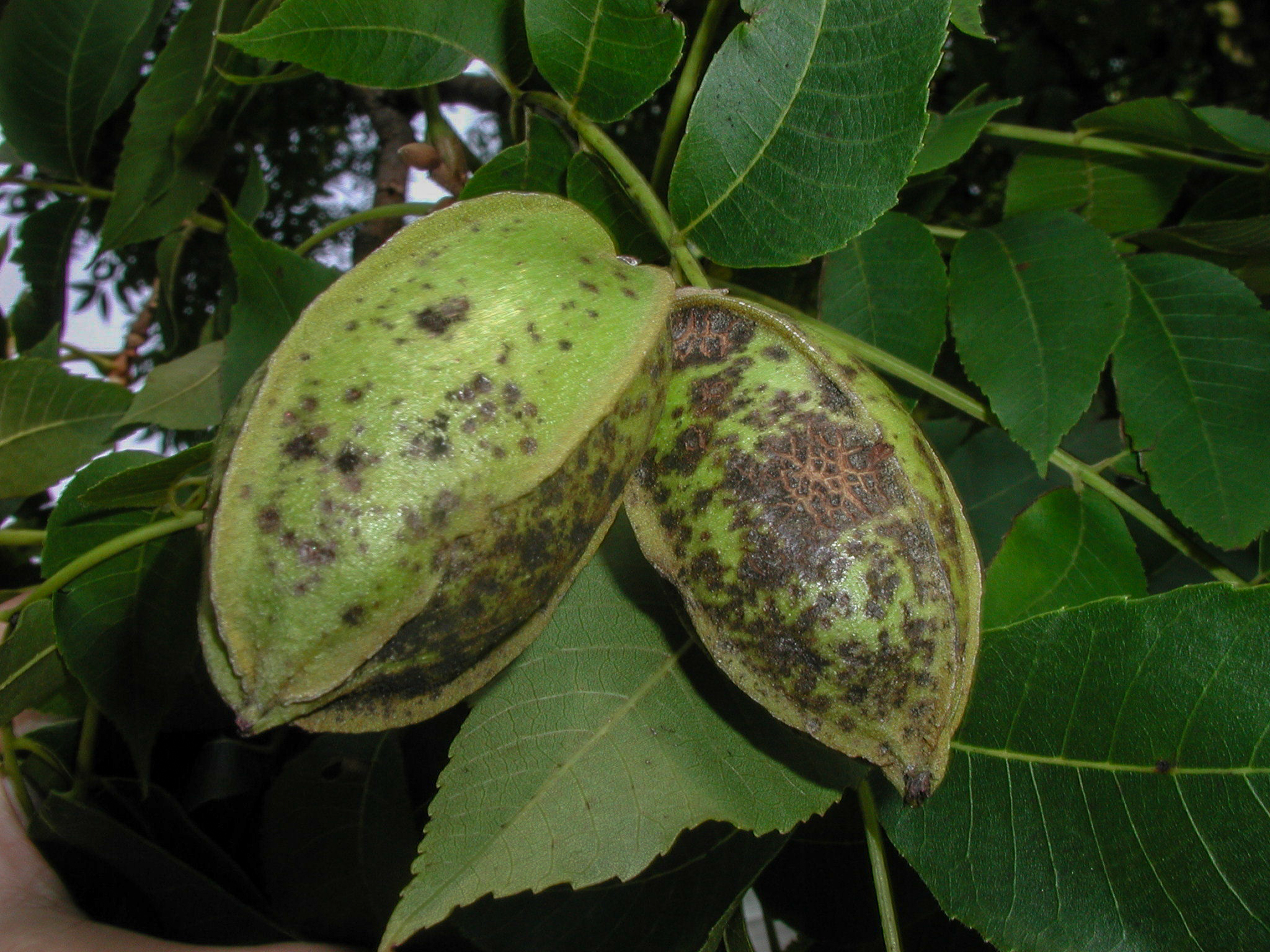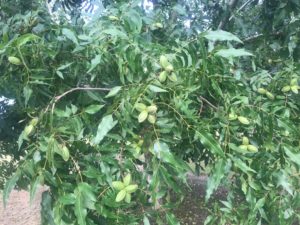Your fungicide spray program can fight pecan scab and decrease production costs
Reevaluating your fungicide program may help you save money in a low pecan market while still protecting your trees from scab.

A 'Desirable' nut cluster with a full scab spray program in Albany, Georgia. (Photo by Lenny Wells)
Since these cultivars vary so widely in their scab susceptibility, it makes sense that your approach to scab control should vary between cultivars as well. Fungicides make up 12 percent of the annual cost of production of pecans in the Southeast. Only labor and fuel gobble up a higher percentage of the budget. In the past, many growers have sprayed at least eight times with fungicide on most cultivars and usually more on highly susceptible cultivars like ‘Desirable’ and ‘Pawnee.’ But lately, a couple of things have changed that may make many growers open to thinking a little more deeply about their fungicide spray program and its cost.
The first event to consider is the decline in the pecan market. We don’t know where the market will settle come harvest time. Still based on last year’s prices, the large volume of nuts held over in storage, and the lingering potential impact of COVID on shipping and demand, growers would be wise to think seriously about ways in which they can cut cost and still provide their trees and crop with needed protection.
The second event to occur is that over the last several years we have added more fungicides to the battery of weapons available to fight pecan scab. The most significant of these have been phosphite and the Group 3 + Group 7 fungicide, Miravis Top.
Phosphite is one of the most, if not, the most highly effective material for managing leaf scab. Stand-alone phosphite applications should be used at the highest labeled rate, usually 2 to 3 quarts per 100 gallons depending on the formulation. Be sure to check the label for the formulation you are using.
Miravis Top’s release in late 2019 has positioned it as the strongest nut scab material currently available for pecans. Dr. Tim Brenneman’s research has demonstrated this, and grower experience has confirmed it. The best thing about phosphite and Miravis Top is that both of these highly effective chemistries are also very affordable.
In all, we have six or seven different chemistries available, including those found in the materials above, in our arsenal of scab materials. This is good news. The key to keeping such a wide variety of tools available is to rotate these chemistries and not overuse them.
All of the fungicides labeled for pecan scab have activity on pecan scab, but some are better than others under high-pressure situations, and some work better on leaf scab than nut scab and vice-versa. Leaf and nut scab are caused by the same organism—Venturia effusa—the fungus that causes pecan scab. The difference is found in the tissues on which the disease grows and how these fungicides perform when applied to these tissues.
The phosphites and the combinations of Group 3 and Group 11 fungicides (think Absolute, Stratego, Quadris Top, Amistar Top, Quilt, Brixen, Custodia, TopGuard EQ, and others) are perhaps the best materials we have available for leaf scab. Once leaves harden off around late May/early June, leaf scab is no longer an issue (except in the case of late-season growth flushes, which will be protected by your nut scab sprays).
So, in June, your focus should shift to nut scab. Miravis Top and Elast applied alone or in the combination of Elast/Tin will give you maximum protection of nuts as they are rapidly developing through the nut sizing stage. But there will be scenarios in which you may need to, or have the option to, use other materials.
Let’s get back to cultivars and how this plays into your opportunities to cut production costs. Growers have lately stopped planting ‘Desirable’ and have switched to more scab-resistant cultivars here in the Southeast. The goal of making this switch is to allow growers to grow pecans successfully with fewer sprays. The high prices we saw until recently allowed growers enough of a cushion to hedge their bets in producing the best nut possible, and many got into the habit of spraying some of these more resistant cultivars just as they did ‘Desirable.’ Once you start doing something like that, it’s hard to wean yourself off of it.
But the time has come to closely evaluate how you are managing scab and consider whether or not some changes can and should be made to reduce your cost of production, based on the cultivars you grow and the micro-climatic conditions in and around the orchard.
Table 1. Pecan Cultivars categorized by scab susceptibility.
| Low | Moderate | Moderate/High | High |
|---|---|---|---|
| Avalon | Creek | Caddo | Byrd |
| Elliott | Kiowa | Cape Fear | Cunard |
| Excel | Kiowa | Huffman | Desirable |
| Kanza | Sumner | Schley | Morrill |
| Lakota | Zinner | Stuart | Pawnee |
| McMillan | Ellis | Tanner | Treadwell |
| Gloria Grande | Tom | ||
| Whiddon |
Overall, it makes good sense to have variable spray programs for cultivars of different scab susceptibility. But bear in mind that the scab susceptibility of any given cultivar can, and often does, shift over time. Also, scab susceptibility for a given cultivar is not the same in every location. Sites on low elevation or surrounded by woods, crowded orchards, a large volume of a given cultivar planted in an area, etc., all influence disease pressure. Growers must take these influences into account.
Given these conditions, we have broken most of our commonly grown cultivars down into four categories based on scab susceptibility: low, moderate, moderate/high, and high. The breakdown of these can be seen in Table 1. The programs for the low and high spray cultivars, as you will see, are pretty self-explanatory.
Most growers know they don’t have to spray things like ‘Elliot,’ ‘Lakota,’ or ‘Excel’ very much at all to make the crop. Likewise, you know that you can’t slack up at all on cultivars like ‘Desirable’ and ‘Pawnee.’ You have to spray those varieties to make the crop. Where it becomes confusing is in the moderate and moderate/high categories. Cultivars that fall into these categories usually may not scab much in some places but can be very susceptible in others. A good example is ‘Cape Fear.’
In most middle Georgia locations, five to seven sprays, depending on the year, should make a ‘Cape Fear’ crop. But I have seen places in Southeast Georgia where it scabs as severely as ‘Desirable.’ These are the types of situations in which you will have to use your own judgment based on your history with a particular orchard to make the call of whether to place a given cultivar in the moderate or high category. In orchards of mixed cultivars, your spray program also should be based on the most susceptible cultivar.
Given the fact that growers have to try and reduce the cost of production where possible, I want to offer the following guidelines and example spray programs for each situation:
Low Susceptibility:
These are cultivars that, in a pinch, could be grown most years with no sprays. We have seen no scab or very little scab on these cultivars, even in wet conditions. However, we don’t recommend not spraying at all. You need minimal sprays to keep down the development of any secondary pathogens—like powdery mildew, downy spot, or zonate leaf spot—that may be normally controlled by your scab sprays. These minimal sprays also act as good insurance against future scab development. Therefore, for low susceptibility cultivars, we recommend the following:
Low Susceptibility Cultivar Fungicide Program |
||
|---|---|---|
| Spray 1: | Phosphite | ~ mid-April |
| Spray 2: | Phosphite | ~ mid-to-late May |
| Spray 3: | 11 + 3 mix | ~ early-mid June |
Moderate Susceptibility:
These are cultivars that will require fungicide sprays to manage scab but on which the disease is usually easily managed without an intensive spray program in most locations. Some of these cultivars can fall into the high susceptibility category in locations with a history of scab on these particular cultivars or under situations of low elevation, poor airflow, or frequent rainfall. Use your best judgment with regard to where these cultivars fit for your location.
Scab on these cultivars should be controlled with seven sprays. If excessive rainfall is occurring throughout the nut sizing period, you can shorten your interval and extend the program out further than seven sprays by continuing to rotate Miravis Top and Elast/Tin in the example below.
Moderate Susceptibility Cultivar Fungicide Program |
||
|---|---|---|
| Spray 1: | Phosphite | ~ mid-April |
| Spray 2: | Phosphite OR 11+3 | ~ mid-May |
| Spray 3: | Miravis Top | ~ mid-June |
| Spray 4: | Elast+Tin OR phosphite | ~ late June |
| Spray 5: | Miravis Top | ~ mid-July |
| Spray 6: | Tin OR Elast+Tin | ~ late July |
| Spray 7: | Miravis Top | ~ early August |
Consider using Phosphite (highest labeled rate) or Tin alone, or a combination of Tin+phosphite or Tin +Group 3, etc., in the place of Elast/Tin in the above moderate fungicide spray program if you have dry conditions and disease pressure is low. This mix will help conserve the most efficacious materials for the highest pressure.
High Susceptibility:
These are cultivars that we know must be sprayed intensively in order to produce the crop. They will require at least 8 to 10 fungicide sprays and likely more in many locations. If you need to extend beyond 10 sprays, continue rotating Miravis Top and Elast/Tin. Bear in mind that some cultivars listed in the moderate category may fall into the high category in some locations.
High Susceptibility Cultivar Fungicide Program |
|
|---|---|
| Spray 1: | phosphite |
| Spray 2: | phosphite |
| Spray 3: | 11 + 3 mix |
| Spray 4: | Miravis Top + phosphite |
| Spray 5: | Elast + Tin |
| Spray 6: | Miravis Top |
| Spray 7: | Elast + Tin |
| Spray 8: | Miravis Top |
| Spray 9: | Elast + Tin |
| Spray 10: | Miravis Top |
There are certainly more fungicides labeled for pecans than what you see listed in the examples above. Their exclusion from these examples does not mean they do not control scab. On the contrary, many are very good fungicides and could be rotated into a program just as easily as what you see above. But, based on Dr. Tim Brenneman’s data, we feel that these chemistries applied at the times shown above will offer maximum protection from leaf and nut scab.
Now that you have guidelines for how to break down these cultivars by scab susceptibility and what potential spray programs to use for each, I fully expect to see an excessively wet summer. Bear in mind that if that indeed is the case and we have an excessively wet year, all bets are off and you will have to spray more for cultivars in the moderate to highly susceptible categories. There is no way around that. However, if we have an average to dry year, the schedules you see above will work.
Under relatively dry conditions, a surfactant won’t improve your scab control enough to warrant the extra expense. But, during excessively wet conditions of frequent rainfall, surfactants should help improve your scab control when using the Group 3 + Group 11 materials, as well as Tin and with Miravis Top. However, we do not recommend using surfactants with Elast or with phosphite materials. Elast is a cationic surfactant itself, and additional surfactants pose an increased risk for burn. Surfactants also increase the risk of phosphite burn, especially at the higher rates used for stand-alone phosphite applications.


